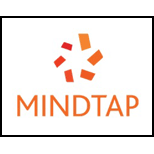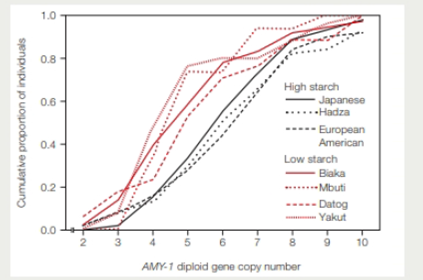
Concept explainers
Human Adaptation to a Starchy Diet The human AMY-1 gene encodes salivary amylase, an enzyme that breaks down starch. The number of copies of this gene varies, and people who have more copies generally make more enzyme. In addition, the average number of AMY-1 copies differs among cultural groups.
George Perry and his colleagues hypothesized that duplications of the AMY-1 gene would be selectively advantageous in cultures in which starch is a large part of the diet. To test this hypothesis, the scientists compared the number of copies of the AMY-1 gene among members of seven cultural groups that differed in their traditional diets. FIGURE 39.16 shows their results.

FIGURE 39.16 Number of copies of the AMY-1 gene among members of cultures with traditional high-starch or low-starch diets. The Hadza, Biaka, Mbuti, and Datog are tribes in Africa. The Yakut live in Siberia.
1. Starchy tubers are a mainstay of Hadza hunter–gatherers in Africa, whereas fishing sustains Siberia's Yakut. Almost 60 percent of Yakut had fewer than 5 copies of the AMY1 gene. What percentage of the Hadza had fewer than 5 copies?
Want to see the full answer?
Check out a sample textbook solution
Chapter 39 Solutions
MindTap Biology, 1 term (6 months) Printed Access Card for Starr/Taggart/Evers/Starr's Biology: The Unity and Diversity of Life (MindTap Course List)
- Human Adaptation to a Starchy Diet The human AMY-1 gene encodes salivary amylase, an enzyme that breaks down starch. The number of copies of this gene varies, and people who have more copies generally make more enzyme. In addition, the average number of AMY-1 copies differs among cultural groups. George Perry and his colleagues hypothesized that duplications of the AMY-1 gene would be selectively advantageous in cultures in which starch is a large part of the diet. To test this hypothesis, the scientists compared the number of copies of the AMY-1 gene among members of seven cultural groups that differed in their traditional diets. FIGURE 39.9 shows their results. FIGURE 39.9 Number of copies of the AMY-1 gene among members of cultures with traditional high-starch or low-starch diets. The Hadza, Biaka, Mbuti, and Datog are tribes in Africa. The Yakut live in Siberia. Do these data support the hypothesis that a starchy diet favors duplications of the AMY-1 gene?arrow_forwardThe human AMY-1 gene encodes salivary amylase, an enzyme that breaks down starch. The number of copies of this gene varies, and people who have more copies generally make more of the enzyme. In addition, the average number of AMY-1 copies differs among cultural groups. George Perry and his colleagues hypothesized that duplications of the AMY-1 gene would confer a selective advantage in cultures in which starch is a large part of the diet. To test this hypothesis, the scientists compared the number of copies of the AMY-1 gene among members of seven cultural groups that differed in their traditional diets. The Figure shows their results. Starchy tubers are a mainstay of Hadza hunter-gatherers in Africa, whereas fishing sustains Siberias Yakut. Almost 60% of Yakut had fewer than 5 copies of the AMY-1 gene. What percentage of the Hadza had fewer than 5 copies? FIGURENumber of copies of the AMY-1 gene among members of cultures with traditional high-starch or low-starch diets. Source: G. Perry et al. 2007. Diet and the evolution of human amylase gene copy number variation. Nature Genetics 39:12561260.arrow_forwardQ: Breast milk from femae humans and other mammals has a variety of nutritious metabolites for growing infantts including antibodies that are passed on from the mother to the child lactose How does jactone enter giyoonysis in the intant's cell? A)it is broken down into alucose, which enters glycolysis directly, and galactose but it is particularly high in the carbohydrate which enters glycolysis after a series of reactions involving a sugqar-nucleotide that epimerize it to a phosphorylated form of glucose B)Its nonveducing end is attacked by norganic phosphate (PI), creating a giycolysis intermediate C) Hexokinase phosphorytates it to create a glycolysis intermediate D) A salivary amylase enryme begins to catabolize it then a pancreatic amylase enzyme continues to catabolize it at lower pH E)it enters giycolysis after a series of reactions involving a sugar-nucieotide that epimerize it directly to a phosphorylated form of glucosearrow_forward
- Importance of vitamine D in human body? Why is iimportant to eat food of good source of fiber? nutrient dense food explains? no pliagiarism pleasearrow_forwardPlz answer correctly do not copy. Question- Arsinate binds to reduced thio groups such as those found in cystiene residues in proteins, lipoate or glutathione. The resulting inhibition leads to central nervous system pathologies. The binding of arsinate to the dihydrolipoyl groups inhibits which of the following enzyme(s)? succinate dehydrogenase malate dehydrogenase pyruvate dehydrogenase complex branched-chain amino acid dehydrogenase complex isocitrate dehydrogenase alpha-ketoglutarate dehydrogenase complexarrow_forwardHelp filling in the blanks: The malate aspartate shuttle plays many roles in carbohydrate and amino acid metabolism. Malate can be transferred into the cytosol and interconverted in one enzymatic step to produce [oxaloacetate/glucose/PEP/pyruvate] for use in the pathway of [glycolysis/gluconeogenesis]. A product of the urea cycle, derived from aspartate, can also be converted to malate in one enzymatic step and shuttled into the mitochondria so that the urea cycle product can be used in [fatty acid synthesis/the citric acid cycle/β-oxidation]. The amino group from aspartate can be transferred to [oxalacetate/malate/fumarate/pyruvate/a- ketoglutarate] to form glutamate, which is then transported into the mitochondria. In fact many amino acids are transaminated in this way to form glutamate in the cytosol. In this way, incoming amino acids from the bloodstream can be shuttled into the liver mitochondria as glutamate for conversion by glutamate dehydrogenase to [glutamate/a-ketoglutarate…arrow_forward
- fill in the blanks The 2C units of acetyl CoA necessary for fatty acid synthesis in the cytosol comes from the 6C compound ( ). The cleavage of this 6C molecule into a 4C and 2C molecule is by the enzyme ( ). Recycling of the 4C molecule back into the mitochondria generates the ( ) molecule nessary for fatty acid synthesis.arrow_forwardPlease answer fast During what phase of CHO digestion do the products of starch hydrolysis break down further to a monosaccharide? Name it. And by what specific process is this product absorbed into the enterocyte?arrow_forwardSkeletal muscle uses lipolysis and b-oxidation to fuel contraction during times of strenuous activity. A marathon athlete has a genetic mutation that renders his carnitine acyltransferase I enzyme inactive. After two hours of running, __________ will be found at abnormally high levels in the __________ of this athlete’s myocytes. Choose (1) answer from column #1 and (1) answer from column #2. Column #1(A) acetyl CoA(B) fatty acid(C) fatty acyl-carnitine (D) fatty acyl CoA Column #2(E) cytoplasm (F) mitochondriaarrow_forward
- β-oxidation A) is the second step in the oxidation of glucose. B) is a process used to oxidize fatty acids. C) occurs in the cytoplasm. D) is a process used to digest some polysaccharides. E) lengthens fatty acids by addition of two carbons.arrow_forward1. Pancreatic α-amylase and small intestinal membrane-bound α-glucosidases are involved in starch digestions. What are the 2 starch molecules? What are their (α-amylase and the α-glucosidases) substrates and products? How do the 2 starch molecules differ from each other in terms of their digestion and products formed? What happens to the starch molecules if either α-amylase or the α-glucosidases or both are inhibited? Why non-starch polysaccharides such as dietary fibers cannot be digested?arrow_forwardMammals in the Arctic (e.g., reindeer) have higher levels ofunsaturated fatty acids in their legs than in the rest of theirbodies. Suggest a reason for this phenomenon. Does it have asurvival advantage?arrow_forward
 Biology: The Unity and Diversity of Life (MindTap...BiologyISBN:9781305073951Author:Cecie Starr, Ralph Taggart, Christine Evers, Lisa StarrPublisher:Cengage Learning
Biology: The Unity and Diversity of Life (MindTap...BiologyISBN:9781305073951Author:Cecie Starr, Ralph Taggart, Christine Evers, Lisa StarrPublisher:Cengage Learning Biology: The Unity and Diversity of Life (MindTap...BiologyISBN:9781337408332Author:Cecie Starr, Ralph Taggart, Christine Evers, Lisa StarrPublisher:Cengage Learning
Biology: The Unity and Diversity of Life (MindTap...BiologyISBN:9781337408332Author:Cecie Starr, Ralph Taggart, Christine Evers, Lisa StarrPublisher:Cengage Learning Biology: The Dynamic Science (MindTap Course List)BiologyISBN:9781305389892Author:Peter J. Russell, Paul E. Hertz, Beverly McMillanPublisher:Cengage Learning
Biology: The Dynamic Science (MindTap Course List)BiologyISBN:9781305389892Author:Peter J. Russell, Paul E. Hertz, Beverly McMillanPublisher:Cengage Learning BiochemistryBiochemistryISBN:9781305577206Author:Reginald H. Garrett, Charles M. GrishamPublisher:Cengage Learning
BiochemistryBiochemistryISBN:9781305577206Author:Reginald H. Garrett, Charles M. GrishamPublisher:Cengage Learning



